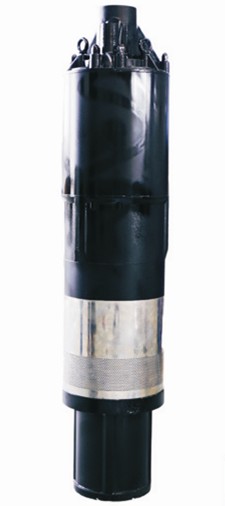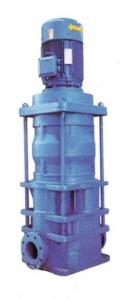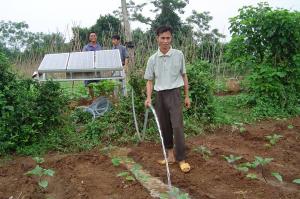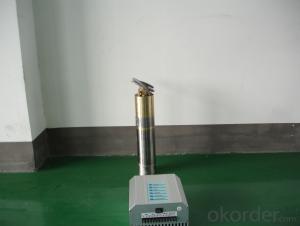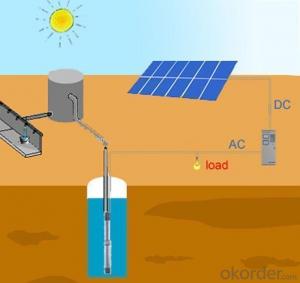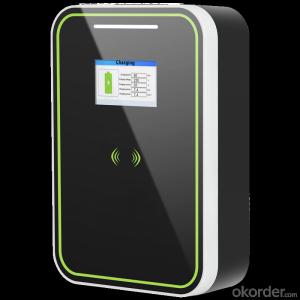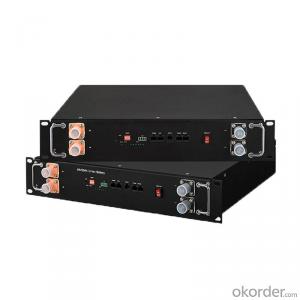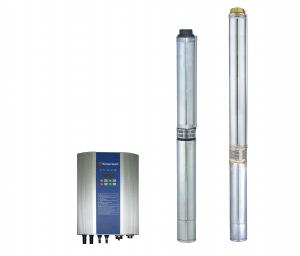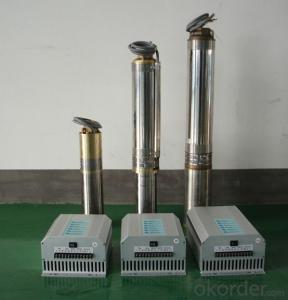Solar Water Pump 3DS-10-50
- Loading Port:
- China Main Port
- Payment Terms:
- TT OR LC
- Min Order Qty:
- -
- Supply Capability:
- 300 sets /month
OKorder Service Pledge
OKorder Financial Service
You Might Also Like
Product description:
Product: Solar water pump
Model:3DS-10
 Appilication:
Appilication:
submersible pump
for deep well or water tank or pond or small lake
for irrigation of a farm cover around 5000 m2
For all kinds of irrigation: flood /sprinkling/ drip
Product specification:
flow rate:8000 liter/ hour, 64m3/day.
lift: 10m-50m
pump diameter: 238mm
well diameter more than 250mm
with BLDC motor, motor power:2000W
but only need solar power:960W, our pump can save more than 50% solar panel power.
Material:
Pump inside: stainless steel and wearable nylon,it enables our solar pump to have 10 years sevice life.
Motor length:30cm,80% shorter than other motors. So that you can pump 80% more water by our solar pump.
Certification:
3 International patent
ISO9001
CE
Warranty:2 years
- Q:Can solar pumps be used in areas with high salt or mineral content in the water?
- Yes, solar pumps can be used in areas with high salt or mineral content in the water. However, it is important to choose solar pumps that are specifically designed to handle such conditions. These pumps are typically constructed with corrosion-resistant materials and may have additional features like built-in filters or desalination capabilities to prevent damage and ensure efficient water pumping.
- Q:Can a solar pump be used in saltwater or corrosive environments?
- Indeed, the utilization of a solar pump is feasible even in saltwater or corrosive surroundings. Nevertheless, it is crucial to opt for a pump explicitly engineered for such circumstances. Conventional pumps might not endure the corrosive impact of saltwater. Seek out pumps constructed from materials such as stainless steel or other alloys that are resistant to corrosion. Furthermore, it is advisable to employ a pump equipped with a sealed motor to avert any harm arising from dampness or saltwater exposure. By meticulously selecting the appropriate pump for the task, solar pumps can be effectively employed in saltwater or corrosive environments, including coastal areas or industrial settings.
- Q:What is the maximum temperature a solar pump can handle?
- The maximum temperature that a solar pump can withstand may differ based on the specific model and manufacturer. Nevertheless, most solar pumps are generally built to endure temperatures ranging from 50-60 degrees Celsius (122-140 degrees Fahrenheit). To determine the exact maximum temperature rating for a particular solar pump model, it is crucial to consult the manufacturer's product specifications. Moreover, it is recommended to install the pump in a location that reduces exposure to extreme temperatures and guarantees sufficient ventilation for optimal performance and longevity.
- Q:Can a solar pump operate at night or on cloudy days?
- No, a solar pump cannot operate at night or on cloudy days. Solar pumps rely on sunlight to generate the necessary energy to power the pump. Without sunlight, there is no energy source for the pump to function. Therefore, the pump will not be able to operate during nighttime or on cloudy days when sunlight is not available.
- Q:Can a solar pump be used for water aeration in ponds and lakes?
- Water aeration in ponds and lakes can be achieved using a solar pump. These pumps operate solely on solar power, eliminating the need for electricity from the grid. By harnessing energy from solar panels, they effectively circulate and aerate the water. This process increases oxygen levels, which are crucial for the survival of aquatic plants and animals. Not only are solar pumps for water aeration environmentally friendly, but they are also cost-effective in the long term due to their independence from traditional energy sources. Moreover, they are easy to install and require minimal maintenance. In conclusion, solar pumps offer a dependable and sustainable solution for water aeration in ponds and lakes.
- Q:How much water can a solar pump supply?
- The amount of water a solar pump can supply depends on various factors such as the size and capacity of the pump, the intensity of sunlight, and the efficiency of the system. Generally, solar pumps are capable of supplying anywhere from a few hundred liters to several thousand liters of water per day. However, it is important to note that this estimate can vary greatly depending on the specific circumstances and conditions at the installation site. Additionally, factors such as the depth of the water source, the distance the water needs to be lifted, and the required pressure can also impact the pump's water supply capabilities. Therefore, it is advisable to consult with a professional or refer to the manufacturer's specifications to get a more accurate estimate of the water supply capacity for a particular solar pump model.
- Q:Can a solar pump be used for water supply in refugee camps or temporary settlements?
- Yes, a solar pump can definitely be used for water supply in refugee camps or temporary settlements. Solar pumps are a sustainable and cost-effective solution for providing water in such areas where traditional electricity supply may be limited or unreliable. Solar pumps utilize solar energy to power their operations, eliminating the need for fuel or electricity. They consist of photovoltaic panels that convert sunlight into electricity, which then powers the pump to extract water from wells, boreholes, or other water sources. The water can be stored in tanks or distributed directly to the community through a network of pipes. There are several advantages to using solar pumps in refugee camps or temporary settlements. Firstly, they are environmentally friendly, producing zero greenhouse gas emissions and reducing reliance on fossil fuels. This not only helps to combat climate change but also reduces the risk of fuel shortages or price fluctuations that can disrupt water supply. Secondly, solar pumps are easy to install and maintain. They do not require complex infrastructure or extensive wiring, making them suitable for remote or challenging locations. Additionally, they have a long lifespan and minimal maintenance requirements, ensuring continuous water supply with minimal downtime. Furthermore, solar pumps are highly reliable. As long as there is sufficient sunlight, they can operate consistently, providing a reliable water supply to meet the needs of the refugee camp or settlement. They can also be equipped with battery storage systems to ensure water supply during cloudy periods or at night. Finally, solar pumps offer cost savings over the long term. While the initial installation costs may be higher compared to traditional pumps, solar pumps have lower operational and maintenance costs. They do not require fuel, and the only ongoing expense is occasional maintenance and replacement of components. In conclusion, solar pumps are an excellent choice for water supply in refugee camps or temporary settlements. They are sustainable, reliable, and cost-effective, providing a consistent source of water without relying on traditional electricity supply. Their installation and maintenance are straightforward, making them an ideal solution for remote and challenging locations.
- Q:How does the performance of a solar pump vary with different solar panel efficiencies?
- The performance of a solar pump is directly affected by the efficiency of the solar panels used. Higher efficiency solar panels convert more sunlight into electricity, resulting in increased power output for the pump. This means that with higher efficiency panels, the solar pump will be able to generate more water flow, operate at a higher pressure, and potentially work during low light conditions as well. On the other hand, lower efficiency panels would produce less power, resulting in reduced pump performance. Therefore, the performance of a solar pump varies significantly with different solar panel efficiencies.
- Q:Can a solar pump be used in areas with limited access to maintenance services?
- Yes, a solar pump can be used in areas with limited access to maintenance services. Solar pumps are designed to be low maintenance and reliable, requiring minimal upkeep. They have fewer mechanical parts compared to traditional pumps, reducing the chances of breakdowns and the need for frequent maintenance. Additionally, solar pumps do not require fuel or electricity, making them ideal for remote areas where maintenance services may be scarce.
- Q:Are there any limitations on the installation location or orientation of solar panels for a solar pump?
- Yes, there are certain limitations on the installation location and orientation of solar panels for a solar pump. The panels should ideally be installed in a location that receives maximum sunlight throughout the day. This means avoiding shaded areas or areas with obstructions like trees or buildings. Additionally, the orientation of the panels should be towards the south (in the northern hemisphere) or towards the north (in the southern hemisphere) to ensure optimal exposure to sunlight.
1. Manufacturer Overview |
|
|---|---|
| Location | |
| Year Established | |
| Annual Output Value | |
| Main Markets | |
| Company Certifications | |
2. Manufacturer Certificates |
|
|---|---|
| a) Certification Name | |
| Range | |
| Reference | |
| Validity Period | |
3. Manufacturer Capability |
|
|---|---|
| a)Trade Capacity | |
| Nearest Port | |
| Export Percentage | |
| No.of Employees in Trade Department | |
| Language Spoken: | |
| b)Factory Information | |
| Factory Size: | |
| No. of Production Lines | |
| Contract Manufacturing | |
| Product Price Range | |
Send your message to us
Solar Water Pump 3DS-10-50
- Loading Port:
- China Main Port
- Payment Terms:
- TT OR LC
- Min Order Qty:
- -
- Supply Capability:
- 300 sets /month
OKorder Service Pledge
OKorder Financial Service
Similar products
New products
Hot products
Hot Searches
Related keywords

